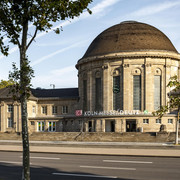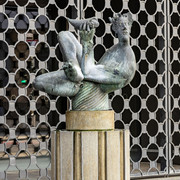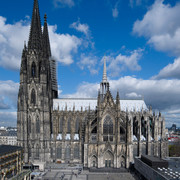Photos & Map
How would you like to arrive?
Details
Useful Information
Nearby
Train stations may not often be the subject of praise songs—but on the rare occasion when someone does, they might speak of the symphonic crescendo of life and movement that envelops them upon entering Cologne Central Station. Or perhaps they would mention the melody of footsteps on the stone floor, interspersed with the rhythmic announcements for upcoming trains. In this uniquely composed soundscape, the voices of travelers float like a multi-voiced choir, telling stories from around the world.
Every tone in this bustling heart of Cologne turns a new page in the book of great travel tales, and together they hum the unmistakable song of Cologne Central Station. A hymn to travel, encounters, and all that encompasses life.
Let's narrate it more soberly: The Cologne Cathedral and the Cologne Central Station—this monumental ensemble of the 19th century—symbolize the connection between the Middle Ages and modern technology. The Cologne Central Station was constructed between 1857 and 1859 as a passenger station on the site of the old Botanical Garden. Today, it is one of the most visited stations in North Rhine-Westphalia, with about 310,000 travelers and passersby each day.
Those not traveling far find a location at the central station that seemingly owes its multitude of impressions to its own versatility—as shopping experience, event location, and modern travel comfort come together daily to create a vibrant mix, forming an attraction in its own right.
As early as 1886, a new building began, and by 1894, there was the large three-part platform hall, inspired by London St. Pancras station. During the restructuring from 1909-1915, visible new additions included the new South Bridge and the four-track Hohenzollern Bridge. During this, the waiting room building in the hall was removed, and all the tracks were converted to through tracks. Only the waiting rooms of the first and second class have survived from the original buildings—having survived WWII and subsequent modifications.
In 1945, the creation of the second forecourt “behind” the central station, Breslauer Platz, began. In 1953, the destroyed western wing was replaced with a modern luggage handling area and a hotel. The old reception building was not demolished until 1955—the perception of this scarcely destroyed and repaired building as a symbol of Prussian authority was too strong.
Electrification began in 1957, alongside the commissioning of a new reception building with a new shell-shaped roof construction and a glazed façade facing the station forecourt.
For luggage storage, head in hyper-modern fashion downward: Cologne Central Station boasts Europe's first fully automated luggage storage system—and the only one of its kind so far. Serving around 1,000 compartments via computer, it handles over 20,000 pieces of luggage per month. One of them could be yours—on your next visit to Cologne.
As early as 1983, Deutsche Bundesbahn, the owner, had separated it from the station gastronomy and leased the premises to Alfred Biolek, the talk show format co-founder and German television legend who found his final resting place at the Melaten Cemetery.
With space for 1,000 guests, today the waiting room serves as a restaurant, bar, nightclub, and event location, offering ample space for events, cabaret or comedy shows, parties, fashion shows, or collector fairs for records, CDs, or comics. Not to mention its offer as a gastronomic, exquisitely stylish historical venue with regional seasonal cuisine and the cocktail and beverage options of a bar.
With its central location, Cologne Central Station also offers all other tourist attractions within walking distance, in addition to the unmistakable Cologne Cathedral, sharing its forecourt—like breweries, museums, or well-known shopping streets like Hohe Straße.
Every tone in this bustling heart of Cologne turns a new page in the book of great travel tales, and together they hum the unmistakable song of Cologne Central Station. A hymn to travel, encounters, and all that encompasses life.
Let's narrate it more soberly: The Cologne Cathedral and the Cologne Central Station—this monumental ensemble of the 19th century—symbolize the connection between the Middle Ages and modern technology. The Cologne Central Station was constructed between 1857 and 1859 as a passenger station on the site of the old Botanical Garden. Today, it is one of the most visited stations in North Rhine-Westphalia, with about 310,000 travelers and passersby each day.
Cologne Central Station: An Experience with Track Connection
Cologne Central Station is considered the western hub for international connections: to Belgium, France, the Netherlands, Switzerland, or Austria with the Eurostar, ÖBB Nightjet, or ICE, thus linking various metropolises in Europe.Those not traveling far find a location at the central station that seemingly owes its multitude of impressions to its own versatility—as shopping experience, event location, and modern travel comfort come together daily to create a vibrant mix, forming an attraction in its own right.
Facts and Figures: Cologne Central Station
More than 1,300 trains travel to domestic and international destinations and make stops at Cologne Central Station every day. Local transport connections also depart here—via subway, tram, and bus. Although the central station is still located in the same spot directly next to Cologne Cathedral as it was in 1859, when it was planned and built as a “central passenger station,” much has naturally changed over the years.As early as 1886, a new building began, and by 1894, there was the large three-part platform hall, inspired by London St. Pancras station. During the restructuring from 1909-1915, visible new additions included the new South Bridge and the four-track Hohenzollern Bridge. During this, the waiting room building in the hall was removed, and all the tracks were converted to through tracks. Only the waiting rooms of the first and second class have survived from the original buildings—having survived WWII and subsequent modifications.
Rebuilding After World War II
Reconstruction after the bombings of World War II took until 1953—originally, there were considerations to relocate the station to where the Media Park now stands.In 1945, the creation of the second forecourt “behind” the central station, Breslauer Platz, began. In 1953, the destroyed western wing was replaced with a modern luggage handling area and a hotel. The old reception building was not demolished until 1955—the perception of this scarcely destroyed and repaired building as a symbol of Prussian authority was too strong.
Electrification began in 1957, alongside the commissioning of a new reception building with a new shell-shaped roof construction and a glazed façade facing the station forecourt.
Since 2000: Colonades – Dining, Shopping & More in the Central Station
Shopping tour instead of luggage storage—over 70 shops have been waiting for you since the renovation of Cologne Central Station from 1997–2000. On more than 11,500 square meters of space, around 700 employees ensure that you lack nothing on your travels and visits to the central station’s modernized areas. The shopping center on the entrance level offers not only classic press & books, gastronomy, and car rental, but also health & care, fashion, and other services.For luggage storage, head in hyper-modern fashion downward: Cologne Central Station boasts Europe's first fully automated luggage storage system—and the only one of its kind so far. Serving around 1,000 compartments via computer, it handles over 20,000 pieces of luggage per month. One of them could be yours—on your next visit to Cologne.
Location Waiting Room and Shopping Around Cologne Central Station
The Alte Wartesaal—as it was called until 2014—and now known as Wartesaal am Dom, structurally belongs to today's Cologne Central Station and is the only original historical building still standing—extensively expanded, renovated, and equipped with modern technology.As early as 1983, Deutsche Bundesbahn, the owner, had separated it from the station gastronomy and leased the premises to Alfred Biolek, the talk show format co-founder and German television legend who found his final resting place at the Melaten Cemetery.
With space for 1,000 guests, today the waiting room serves as a restaurant, bar, nightclub, and event location, offering ample space for events, cabaret or comedy shows, parties, fashion shows, or collector fairs for records, CDs, or comics. Not to mention its offer as a gastronomic, exquisitely stylish historical venue with regional seasonal cuisine and the cocktail and beverage options of a bar.
With its central location, Cologne Central Station also offers all other tourist attractions within walking distance, in addition to the unmistakable Cologne Cathedral, sharing its forecourt—like breweries, museums, or well-known shopping streets like Hohe Straße.
Useful Information
General Information
Parking Available
Bus stop available
Eligibility
Suitable for any weather
for Groups
for Class
for families
for individual guests
Suitable for the Elderly
Suitable for Pushchair
Parking facilities
Cologne Central Station is located on the left bank of the Rhine and is the starting point for your trip to Cologne. Tram rail lines 5, 16 and 18 stop there, as do local and long-distance Deutsche Bahn trains.
Our recommendations
Nearby











